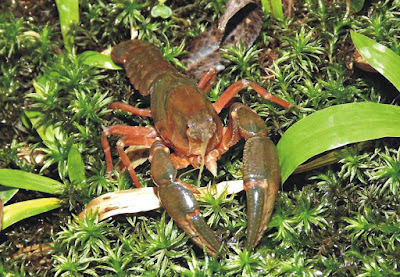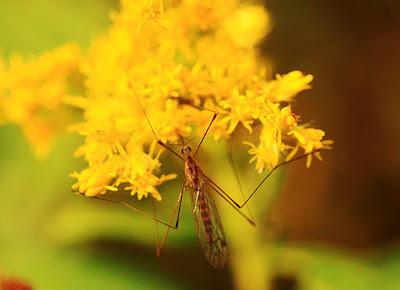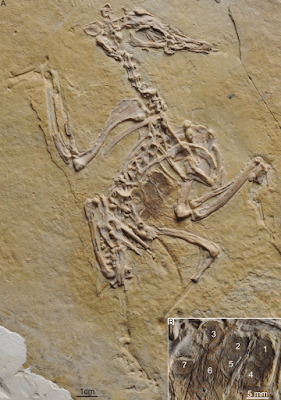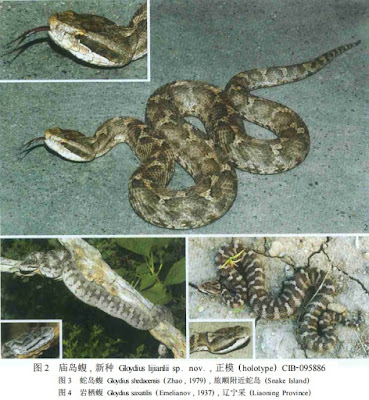[Most Recent Entries] [Calendar View]
Tuesday, August 30th, 2016
| Time | Event | ||||
| 5:19a | [Crustacea • 2016] Parastacus fluviatilis & P. caeruleodactylus • Two New Species of South American Freshwater Crayfish Genus Parastacus Huxley, 1879 (Decapoda: Parastacidae)
Abstract Two new species of Parastacus Huxley, 1879 are described from material collected in the state of Rio Grande do Sul, southern Brazil: Parastacus fluviatilis sp. nov. from highland streams and Parastacus caeruleodactylus sp. nov. from wetlands. Parastacus fluviatilis sp. nov. is distinguished mainly by large chelipeds with dense setae cover on the cutting edge of fingers, telson subtriangular with two lateral blunt spines and strongly concave ventral surface of lateral process of thoracic sternites 6 and 7. Parastacus caeruleodactylus sp. nov. is distinguished mainly by blue cheliped fingers and a large gap between them, reduced abdomen, dorsal and ventral margins of dactylus, propodus and carpus of second pair of pereiopods with tufts of long setae and mid-dorsal carina of exopod of uropods unarmed. According to IUCN Red List criteria both species are considered endangered. Habitat characterization and a method for defining the shape of second abdominal pleura are also provided. Keywords: Crustacea, burrowing crayfish, freshwater decapods, neotropical crustaceans, parastacid, taxonomy Felipe Bezerra Ribeiro, Ludwig Buckup, Kelly Martinez Gomes and Paula Beatriz Araujo. 2016. Two New Species of South American Freshwater Crayfish Genus Parastacus Huxley, 1879 (Crustacea: Decapoda: Parastacidae). Zootaxa. 4158(3); 301–324. DOI: 10.11646/zootaxa.4158.3.1 | ||||
| 9:14a | [Entomology • 2016] Five New Species of Geranomyia Haliday, 1833 (Diptera, Limoniidae) from China
Abstract The following five new species of the genus Geranomyia from China are described and illustrated: Geranomyia baisensis sp. nov., G. degenerata sp. nov., G. longispina sp. nov., G. maculata sp. nov. and G. nigra sp. nov.. Three known species, G. apicifasciata (Alexander, 1930), G. radialis (Alexander, 1930) and G. sparsiguttata (Alexander, 1937), are listed with new distribution data. A key to the species of the genus Geranomyia from China is presented. Keywords: Diptera, Limoniidae, Geranomyia, new species, China Xiao Zhang, Zehua Zhang and Ding Yang. 2016. Five New Species of Geranomyia Haliday, 1833 (Diptera, Limoniidae) from China. Zootaxa. 4154(2); 139–154. DOI: 10.11646/zootaxa.4154.2.2 | ||||
| 9:24a | [PaleoOrnithology • 2016] Linyiornis amoena • A New Jehol Enantiornithine Bird from Jiufotang Formation, China, with Three-dimensional Preservation and Ovarian Follicles
ABSTRACT We report a new enantiornithine bird, Linyiornis amoena gen. et sp. nov., from the Lower Cretaceous Jiufotang Formation in northeastern China. Traces of ovarian follicles indicate that the specimen represents a female individual. The nearly three-dimensional preservation of the new specimen reveals morphological details rarely visible in other Early Cretaceous enantiornithines, allowing more detailed comparison with Late Cretaceous enantiornithines. Differences in the preserved morphology of the right and left coracoids suggest that the appearance of some features is strongly affected by preservation, indicating that the distribution of these features in compressed specimens may need to be reevaluated. Like Late Cretaceous enantiornithine specimens, the holotype of Linyiornis amoena preserves a hypertrophied pit for muscle attachment on the bicipital crest but clearly did not preserve a fossa for the capital ligament, present in Late Cretaceous taxa; we discuss the functional morphology and implications of these features in Linyiornis amoena.
Yan Wang, Min Wang, Jingmai Kathleen O'Connor, Xiaoli Wang, Zheng Xiaoting and Xiaomei Zhang. 2016. A New Jehol Enantiornithine Bird with Three-dimensional Preservation and Ovarian Follicles. JOURNAL OF VERTEBRATE PALEONTOLOGY. 36(3); e1054496. DOI: 10.1080/02724634.2015.1054496 http://zoobank.org/urn:lsid:zoobank.org:p | ||||
| 9:42a | [Herpetology • 2009] Gloydius lijianlii • A New Species (Squamata, Viperidae) from the northern Coastal Islands along Shandong Peninsula, China
Abstract The morphological characteristics of thirteen specimens (7♂♂, 6♀♀) on the snake genus Gloydius from northern coastal islands along Shandong Peninsula have been examined,and also compared carefully with reference to the related species records. They are considered as belonging to a new species. Diagnosis of the new species is given as follows. Key Words: Reptilia, Squamata, Viperidae, Gloydius, new species. JIANG Fan and ZHAO Er-Mi. 2009. Gloydius lijianlii, A New Species from the northern Coastal Islands along Shandong Peninsula, China (Reptilia, Squamata, Viperidae). [in Chinese]. Acta Zootaxonomica Sinica. 34(3): 642-646. 江 帆, 赵尔宓. 2009. 山东半岛北部沿岸岛屿蝮属一新种 ( 爬行纲 , 有鳞目, 蝰科). http://bbs.pxtx.com/thread-887787-1-1.do | ||||
| 4:12p | [Paleontology • 2016] Liaoningosaurus paradoxus • Fish Hunting Ankylosaurs (Dinosauria, Ornithischia) from the Cretaceous of China
All ornithischian dinosaurs are herbivorous or omnivorous. Ornithischian Liaoningosaurus paradoxus Xu et al., 2001 is an ankylosaur. Here we report a new specimen of L. paradoxus from China. It contains a number of fish skeletons. We interpret those remains as stomach or gut contents and hence as strong evidence for the meat-eating diet of the dinosaur. With elongate and fork-like denticles of cheek tooth crowns, L. paradoxus has a dentition capable of penetrating into animals like small fishes. The carnivorous adaptation of the dinosaur is also supported by the ungual modification to a sharp claw in both the fore-and hind-limbs. The evolution of a shield-like ventral armor plate and the loose sacrum-pelvic connection suggest that L. paradoxus may have adopted an aquatic way of life,using the ventral armor plate to protect the body from underwater attacks; as such,the open suture between the neural arch and centrum of the vertebrae cannot be used to indicate the juvenile nature of the type specimen. L. paradoxus is the first carnivorous ornithischian dinosaur since dinosaur was first known in the 18th century and represents not only the first aquatic or semi aquatic example of armored dinosaurs but also the smallest species of ornithischian dinosaur so far known. Key Words: Ankylosauria, Nodosaurids, Early Cretaceous, Yinxian Formation, Western Liaoning Ji Q., Wu X., Cheng Y., Ten F., Wang X. and Ji Y. 2016. Fish Hunting Ankylosaurs (Dinosauria, Ornithischia) from the Cretaceous of China. Journal of Geology (Chinese). 40: 183-190; DOI: 10.3969/j.issn.1674-3636.2016.02.183. |
| << Previous Day |
2016/08/30 [Calendar] |
Next Day >> |











